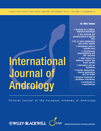Increase in progressive motility and improved morphology of human spermatozoa following their migration through Percoll gradients
Abstract
Human spermatozoa were separated on the basis of their motility in a discontinous Percoll-gradient made up in tissue culture medium containing 10% (v/v) human serum (TCMS). Portions of ejaculates were placed on top of the gradients. After 3 h at 37°C the bottom 1.5 ml was collected and the sperm washed free of the Percoll solution by centrifigation at 240 × g after dilution in TCMS. In this way the spermatozoa were separated from seminal fluid by means of the swimming rate of the sperm. When semen samples from normal men were used, total recovery of sperm after separation on a Percoll gradient was 21 ± 2.3%. The progressive motility index increased by a factor of 15 ± 1 when comparing separated samples with the same unseparated ejaculate, and the frequency of sperm with normal morphology increased from 60 to 85%. The improvements in these semen samples was attributable to the Percoll separation as the washing procedure itself was without effect. Using this method sperm of relatively unifirm motility and morphology can be collected. These may then be used for further biochemical and physiological studies. Improved sperm quality was also obtained when samples from patients with abnormal semen profiles were separated in this way, although the degree of improvement was much more variable than that obtained with semen from normal fertile men. This indicates that this method can be used in clinical practice in selected cases for the preparation of sperm for insemination or for in-vitro fertilization.




